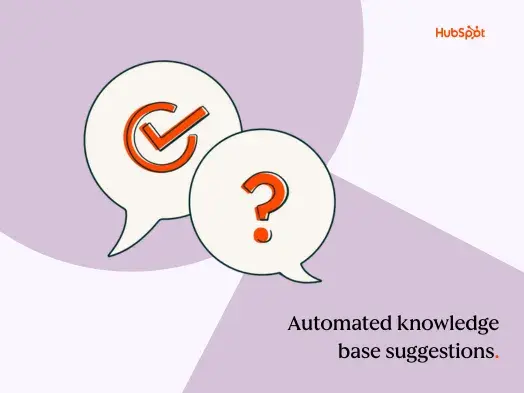This area is ripe for AI adoption and a great place to start.
We're going to delve into how service teams are currently using AI to their advantage, the benefits and limitations of using AI in customer service, and some tools and tips for using AI to enhance your customer service programs.
Table of Contents
- How Service Teams Use AI to Communicate With Customers
- Advantages and Limitations of Using AI in Customer Communication
- AI Tools to Help Your Communication With Customers
- Tips for Using AI in Customer Communication
- Important Considerations
How Service Teams Use AI to Communicate With Customers
To help service teams gain AI inspiration, let's explore current AI uses in customer service communications as well as how other business sectors use AI to improve connection and communication with their customers.
Customer Support
Customer support professionals are primarily using AI to provide 24/7 communication with their customers.
Chatbots excel at immediately acknowledging customers at any time of day or night. Then, behind-the-scenes automation sends work tickets to the proper customer service agents.
They are also using AI to collect and analyze customer feedback in order to learn more about what aspects of their service structures work well and which don't.
This provides actionable insight that can improve future communications, services, and products.
The most visible way customer service teams use AI is by automating initial communications in order to help customers solve simple issues independently.
This frees up representatives to focus their efforts on close communication with customers who have more complex problems to solve.
Sales
Salespeople are using AI to ramp up efficiency, saving two or more hours a day by automating routine communication and prospect outreach tasks.
Of salespeople surveyed, 85% said that AI/automation not only saves time but also makes their prospect outreach more effective.
Sales teams report that using AI cuts down their busy work, enabling them to focus on the customer-specific art of selling.
Using AI to collect and analyze customer data helps salespeople learn more about potential customers before they do their outreach.
Knowing a bit about who they are contacting, 72% say that it helps them more quickly build rapport in their communications.
Only 24% of sales professionals reported using AI/automation — which is exciting because there's clearly a lot of room for AI and automation growth in this sector as well.
Marketing
Marketers use AI primarily to conduct market research and analyze/report on data in order to learn about their prospective customer's needs, wants, and behaviors.
They use this information in order to be the business that meets their customers where they are with the solutions they need.
This information is then used in generative AI to quickly create better content for their customers that also performs better to meet marketing goals.
A whopping 89% of marketers using AI say that generative AI improves the quality of their content.
Are you starting to think about new ways that customer service teams might use AI? It's still a young science with most of its innovations yet to come, so new ideas can be uniquely impactful during this still-early time of development.
Advantages and Limitations of Using AI in Customer Communication
If you're hoping for an all-knowing, all-solving, (dare we say, sentient?) customer communication robot, you've still got a long time to wait.
The vast majority of progress in AI is task-based, and we're still learning where the happy line is between machine efficiency and human satisfaction with an AI interaction.
The developments in machine learning (training machines to do tasks) and deep learning (complex pattern recognition within data) are exciting and increasingly useful.
In today's practical application, though, AI communication has important advantages and limitations to consider.
Advantages
Accessibility for Customers
Anyone who can speak can now get help through AI applications simply by asking them aloud.
It doesn't matter how well you read, write, which language you speak, or how proficient you are with computers — access to information continues to grow as communications AI is incorporated into phones, homes, and public spaces.
Operational Efficiency for Businesses
If your company embraces AI, employees will be your best resource to figure out how AI can improve operations in their vertical.
They know their job and can help the organization identify areas where a chain of automated tasks could maximize efficiency.
For example, a CEO may want their company to use AI to increase efficiency but not know what that looks like for, say, their quality assurance team.
An experienced QA team might know that it would be useful for an AI program to:
- Record customer service audio.
- Scan the audio for keywords that often indicate a problem.
- Create a transcript of the audio event if the keywords are found.
- Create a short summary of the event.
- Add the event and documents to a folder of problematic events for review.
- Email the QA professional to let them know there's an event to review.
Reduced Handling Time/Improved Customer Experience
One of the best advantages of adding AI to customer service communications is that workflow can be strategically distributed, improving the overall customer experience.
Once upon a time, you called a business and spoke with a receptionist who would listen to your situation and route your call to the right person. If they received five calls at once, four people hung up, frustrated that they couldn't get through.
We all know that automated phone trees are far from perfect, but they did solve that problem by picking up every call and moving customers toward their goal.
Many of the callers were able to get what they needed without speaking to the receptionist, and the caller who really did need the human for a complex reason was able to reach them.
Consistent User Experience Across Your Channels
AI and automation tools are becoming available all the time, with new features targeted to simplify, unify, or improve a customer's experience with your business.
There are now AI programs that create consistently branded avenues for your customers to access service across all of your channels.
This is a great way to use AI to meet your customers where they are, regardless of their preferred social platform or instant messaging service.
Whether they like to talk, text, or record audio/video to reach out to you for help, you can be there to answer and give them a great customer support experience.
Limitations
Human Distrust of Automation
We have all experienced the rage-inducing tedium of long phone trees, circular ones that bring you back to the beginning, or dead ends that dump the call, so you have to start all over again.
There is often an inherent distrust that automated customer service systems will do nothing but waste a customer's time, and the challenge is to overcome that distrust.
Designing the shortest and most competent journey to the solution or to a human is the best way to gain your customers' trust.
People can sense when a company values their time, and an efficient automation experience instills confidence that your company:
- Has its act together
- Has reps that are truly prepared to understand and solve the problem.
Inauthentic-feeling Communication
It used to be immediately obvious when you were working with a chatbot. The questions and responses were limited and dull.
Time and technology kept rolling, and developers understood the assignment: There's a social-emotional component to communication that makes it feel more satisfying — and less like repeating yourself to an inept toaster.
Natural language processing (NLP) is a type of machine learning focused on lingual communication with humans.
NLP AI learns to read, listen, and understand meaning and intent in human language. This, in turn, makes it easier to train the AI to respond appropriately and authentically during a human interaction.
In other words, it's getting better but remains a work in progress. A fun example is when you say something sassy to Siri or Alexa, they are sometimes able to recognize it and offer up some delightfully stinging clap back.
Lack of Empathy
AI can be programmed to approximate giving a hoot about your situation, but it literally cannot. Empathy is defined as "the ability to understand and share the feelings of another."
AI currently cannot understand, share, or properly value the emotional distress of humans when something goes wrong, and they need help.
No matter how well we train machines to identify our use of emotive language, they will have no visceral understanding of what your customer is going through.
Even if it solves the functional problem at hand, it won't have the deft touch of an empathetic human to turn a crisis into a conversion like a human customer service professional can.
Data Storage and Security Costs
In our brave new world where massive collections of data have become so useful for machine learning, it's tempting to collect everything you can from customers and build up to the much-hyped Big Data.
But with Big Data comes big legal responsibility — and cost for both storage and security.
Data sets can be lucrative as a simple asset for sale or as part of your business's AI growth plan. But consumer protection laws still stand and must be incorporated into your plan.
If you're not really sure what data is both legal to use and genuinely useful, it's best to consult with an attorney and an AI professional. They can help you figure out what's legal to keep and worth the cost to store and protect.
Sometimes It's Wrong
An entire planet full of fallible humans have uploaded their opinions onto the internet. Now learning algorithms are scanning that soup for answers — what could go wrong?
Advanced search algorithms sift out junk content and deliver relevant, up-to-date, and accurate information to the best of their ability.
Unfortunately, bogus or biased info still gets through — especially when that bogus or biased information is ingrained in human culture or newly popular.
Even when the AI functions perfectly, the output can be misinformed by the input.
Another way AI information can be incorrect is when the software is programmed to create answers by determining the likelihood that it is true.
For example, let's say the data set your AI is training on teaches it that the wealthiest person in the world is Bernard Arnault, and his net worth is in the billions of dollars.
It also learns that the second wealthiest person is Elon Musk at $191 billion.
Then let's say it determines that there is an average wealth difference of 2B between each of the 10 wealthiest people on Earth.
It could reason that Bernard Arnault's net worth must be greater than Musk's $191B, that it's likely to be 2B more, and that Bernard Arnault's net worth — based on the data provided — is highly likely to be $193B.
It may provide that answer as truth, but the truth is that Bernard Arnault's net worth is $202B. The AI came up with an incorrect number because it chose an answer that was highly likely to be true based on the data it was provided.
AI hallucinations are a third way AI content generators are getting things wrong.
A high-level algorithmic hiccup has been observed in AI tools where the output does not follow the input. It's often due to the AI finding an unintended pattern in its training data.
Many educators have experienced this hiccup when children give an answer on a test that is surprising and technically correct, but not the answer an educator intended or expected in the context of what they were trying to teach.
AI Tools to Help You Communicate With Customers
1. HubSpot's Chatbot Builder

Pricing: A free version is available for HubSpot CRM users
Core Features
- You can choose among chatbots designed for various goals
- Lets you visually build and refine your unique chatbot
- Does not require any coding knowledge
- Copy can be customized to match your brand voice
- Pushes new customer data from chats into the CRM to keep customer data fresh
Best for: HubSpot CRM users who have compiled customer data within the CRM. The bot can pull from your data to create personalized chat replies. It's an easy segue into using AI in customer communication and is included as a free tool in the CRM Suite.
2. OpenAI's ChatGPT (Version GPT-4)

Pricing: $20 per month for access to ChatGPT Plus
Core Features
- Create customer communications using cutting-edge natural language processing
- Connect to company data to increase organization-specific accuracy in chat responses
- Can be spoken to by you or your customer in place of text-based interactions
- Is often integrated into other useful tools, acting as the brain of novel applications
Best for: Experts who want to build something powerful from the ground up. If a large organization were to hire an AI development team, they might go this route to push the boundaries of AI use into what could be done next in a rapidly evolving field.
3. Netomi

Pricing: A free demo is available. Pricing is available upon request.
Core Features
- Known for its excellent UX, Netomi is easy to use while also delivering world-class service at the enterprise level
- Omnichannel integration enables businesses to automatically address customers via social media
- Designed for smooth transitions from automation to human reps
Best for: Enterprise use, cutting customer wait times. Netomi was among the first to bring AI to the customer service scene, and they have been learning and improving through experience.
4. CSML.dev

Pricing: A free version is available. Pro plans cost $20 per month and include a 30-day free trial. Enterprise plans cost $1,500 a month.
Core Features
- Integrates with over 100 apps, helping developers quickly add customized value to their automation programs
- Offers a library of chatbot templates to quickly get started with the right basic tools for your project
- Chatbot analytics to gain insight into customer use
Best for: Developers who want to use CSML (an open-source computer language created specifically for conversational AI design) to experiment with and infinitely scale customer service automation programs.
5. Conversica
Pricing: A free demo is available. Paid plans start at $2,999 a month.
Core Features
- Engages customers early and often to identify and solve issues
- Designed with user personas to better identify and communicate with customers
- A/B Testing
- Integrates with Salesforce
Best for: Businesses with intentions of serious revenue growth and a serious budget to match. The ability to do A/B testing is a major feature that can more acutely address different segments of your market.
Having your automation tailored to various customer personas increases authenticity in communications and better meets the needs of your known customer types.
Tips for Using AI in Customer Communication
Identify your team's needs.
Seek input from your boots-on-the-ground customer service team to identify ways that AI will be most useful to them and the customers they regularly serve.
Choose your AI/automation program (or design one) that best meets the needs of both.
Provide training in AI.
Provide AI training for your teams. Even the best and most intuitive tools in the world won't help if your service teams don't have emotional buy-in and proper training.
Help them feel comfortable with the integrations before going live to keep customer service as streamlined as possible.
Consider your language needs.
The more global your company, the more language options you should offer. Be sure to keep this in mind at the beginning of your search for the right automated service program for your organization.
Train your AI.
Customize wherever possible. Training your AI to communicate more naturally with your various market segments will meet their needs better and build trust in your business.
Survey your customers.
Collect and be responsive to customer input. Many customer service automation programs have built-in analytics to help you understand how the new AI is impacting your service program.
Plenty of customers will have opinions about the experience as well. Make sure to respond to input and be ready to iterate for the best results.
Important Considerations
AI and automation have been proven to make big impacts on customer service programs that benefit the business at large.
Surprisingly, only 18% of customer service professionals in our recent survey reported using AI.
This low statistic could be due to a misunderstanding of what counts as AI/automation — the definitions of AI are still a bit hazy for most people.
What is crystal clear is that there is a huge opportunity for growth in the customer service sector using these emerging technologies.
There are several important considerations when choosing or designing the best automated customer service solutions for your business, but the first and key question to answer for your organization is:
- What is stopping you from leveraging AI in customer communications?
- Concerns about the accuracy of AI information? That's why you still need experienced humans to review the output and be ready to work more deeply with customers who have advanced issues to solve.
- Needing more AI literacy and training across your verticals? That's why you still need humans in management to arrange training and bring your teams up to speed in a rapidly changing tech environment.
- Is AI/automation really that important/worth the investment? The way things are going, in order to stay competitive, the answer is yes. In the next few years, these technologies and their abilities to assist businesses will grow exponentially. They already have!
We are taking the next steps with ChatSpot, and encourage you to find your own avenues to successfully incorporate AI into your customer service strategy.
Customer Service









.png)

-2.png)

